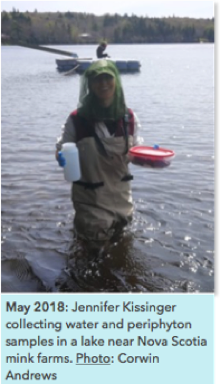
The effects of mink farms on lakes in Nova Scotia
Our lab is collaborating with researchers from other universities to assess how mink farms are affecting lake water quality.
Mink farmers in southwestern Nova Scotia produce about half of Canada’s mink pelts, mostly intended for export. These mink farms are concentrated in some areas, for example over 40 active mink farms are found near the headwaters of the Carleton River alone. Mink farming is a big business in the region, raising over $125 million annually, and comparable only to dairy in terms of agricultural revenues. Despite the clear economic benefits that mink farms bring to the region, they are also at the centre of controversy because of their suspected impacts on water quality. Ongoing public debates between mink farmers, local residents, and public regulators are polarizing in rural communities as the economic benefits of mink farms are weighed against their environmental costs. Many residents blame mink farms for frequent algal blooms, bad odours, illnesses in livestock, and risks to human health as a result of agricultural runoff from the mink farms.
Our lab has joined other collaborators at Queen’s University, Acadia University, and Mount Alison University to conduct an assessment of water quality near mink farms, focusing on lake sediment records as a means to assess whether changes to water quality can be directly attributed to mink farms.
One project is exploring how sterols may be applied to determine inputs form mink farms into lakes in dated lake sediment records, in a similar manner that we are using them to track inputs from water bird colonies. We are also exploring how contaminants that bioaccumulate in mink, like mercury, polychlorinated biphenyls, and other persistent organic pollutants, may be enriched in lakes adjacent to mink farms. These projects will join others by our team members who are studying the effects of nutrients from mink farms on algal blooms and other aquatic organisms.
